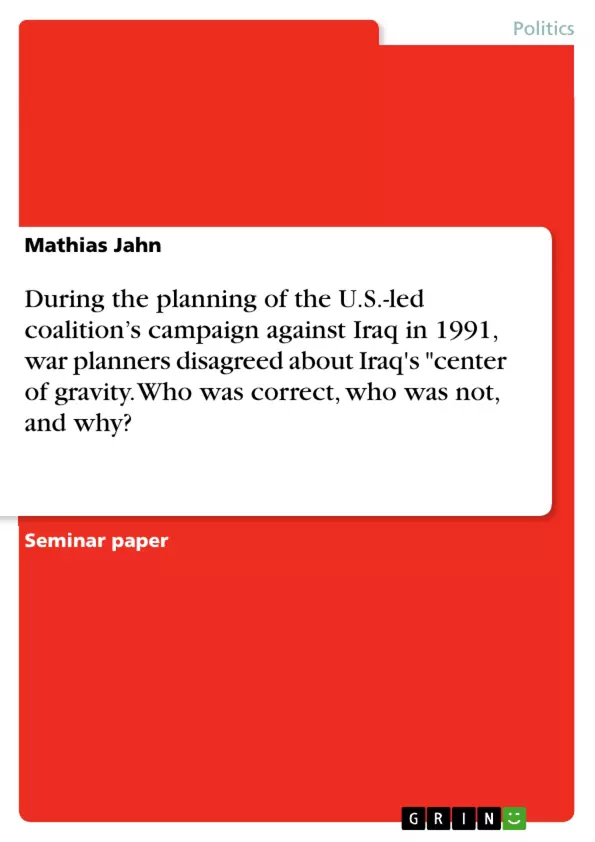Following grand strategy, counter-conspiracy, and economical compensation rationales of Hussein, Iraq invaded Kuwait in August 1990. Mainly supported by 'United Nations Security Council Resolutions 660 and 678, the U.S., as of January 1991, led a 'Western-Arab Alliance (WAA)' to achieve the withdrawal of 'Iraqi Armed Forces (IAF)' from Kuwait under 'Operation Desert Storm'. To reach the objective of the limited war, political and military leaders displayed differing opinions about effective ways by using the 'Center of Gravity' concept. The paper suggests that politicians, without using the technical term 'CoG', tacitly showed a more accurate theoretical appreciation of the concept for guiding their planning (foresight lens), which proved more effective in terms of achieving the outcome (hindsight lens).
To reach this conclusion, 'Chapter 2' will develop a deepened interpretation of the concept based on systems theory. 'Chapters 3 and 4' then contrast and assess the views of political and military leaders by referring to the previous findings and applying the lenses mentioned above. Finally, 'Chapter 5' will conclude by answering the questions of who was correct and why as well as by outlining the further need for research.
Inhaltsverzeichnis (Table of Contents)
- 1. INTRODUCTION
- 2. CENTER OF GRAVITY
- 3. POLITICAL VIEW.
- 4. MILITARY VIEW.
- 5. CONCLUSION
Zielsetzung und Themenschwerpunkte (Objectives and Key Themes)
This paper analyzes the differing opinions about the effective use of the "Center of Gravity (CoG)" concept during the 1991 U.S.-led coalition campaign against Iraq. It contrasts and assesses the views of political and military leaders, arguing that politicians, while not explicitly using the term "CoG," had a more accurate theoretical understanding of the concept. The paper then delves into the theoretical basis of the "CoG" concept, drawing on systems theory to explore its implications for limited wars.
- The "Center of Gravity" concept and its theoretical foundations
- The differing perspectives of political and military leaders on the "Center of Gravity"
- The application of systems theory to understanding the "Center of Gravity" in war planning
- The effectiveness of the "Center of Gravity" concept in achieving desired outcomes in limited wars
- The evolution and practical application of the "Center of Gravity" concept in U.S. military doctrines
Zusammenfassung der Kapitel (Chapter Summaries)
- Chapter 1: Introduction provides background on the U.S.-led coalition's campaign against Iraq in 1991 and outlines the differing opinions on the "Center of Gravity" concept among political and military leaders. It introduces the paper's argument that politicians' theoretical understanding of the concept proved more effective.
- Chapter 2: Center of Gravity delves into a deeper interpretation of the "CoG" concept based on systems theory. It discusses the emergent nature of the "CoG" and its implications for indirect attack strategies. It also explores the applicability of the "CoG" concept in limited wars, drawing on the concept of homeostasis.
- Chapter 3: Political View analyzes the political leaders' perspective on the "CoG" concept during the campaign against Iraq. It examines their theoretical understanding and practical application of the concept, highlighting its role in achieving the desired outcome.
- Chapter 4: Military View examines the military leaders' perspective on the "CoG" concept during the campaign against Iraq. It contrasts their approach with that of the political leaders, highlighting the challenges and limitations of applying the "CoG" concept in practice.
Schlüsselwörter (Keywords)
The key terms and concepts explored in this work include: Center of Gravity (CoG), systems theory, limited war, political strategy, military strategy, Operation Desert Storm (ODS), Iraqi Armed Forces (IAF), United Nations Security Council Resolutions (UNSCRs), Western-Arab Alliance (WAA), homeostasis, emergent phenomenon, indirect approach, Effects-Based-Operations (EBO), foresight lens, hindsight lens.
- Arbeit zitieren
- Dr. phil. Mathias Jahn (Autor:in), 2022, During the planning of the U.S.-led coalition’s campaign against Iraq in 1991, war planners disagreed about Iraq's "center of gravity. Who was correct, who was not, and why?, München, GRIN Verlag, https://www.grin.com/document/1291679



